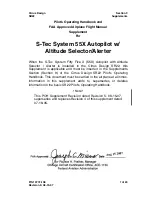
Auto-Tack Function
The following addilional trial is
recommended:
Steer onto a constant heading
approximately
free of close
hauled
Press Auto to lock onto the current
heading or
red keys lo lock
apparenl wind if a vane is filled.
l
Decrease the apparenl wind angle
(using the
key if on the slarboard
lack)
the
is sailing close
hauled al oplimum penetration.
l
Prepare to lack and then press
+ 1
and
keys together (if on the
starboard lack) to initiate a lack
I
O
slarboard.
l
The yacht will
a
course
change
IO
bring it onto
opposite
lack.
1
.
On compleling lhe lack and having
sheeted and retrimmed
sails,
vessel may be brought
the desired
apparent wind angle by fine adjuslmenls
lo
course using
keys. No
adjuslmenls should be made within 1
minute of compleling the lack lo allow the
Autopilot lo
for
helm trim
on
new lack.
Disengagement
The
is held
engagement
wilh the
pin by
of
unit. This
of
engagement is secure and has been
adopted for safely reasons lo allow
lo be easily disengaged when
manual override becomes necessary.
OFF-COURSE ALARM
When
autopilot is set lo either Auto or
Vane mode a built in off-course alarm is
sel up. The off-course
alarm will sound when the vessel
deviales for any reason from
original
course by more than 15 degrees for over
10 seconds. II is denoled by a continuous
series of bleep lones.
The alarm will be silenced if the vessel
returns to within 15 degrees of the
original course.
In Auto, if
vessel does not return
within these limils the alarm can only be
silenced by selecting Standby.
In Vane,
alarm will sound when the
wind direction changes by more lhan 15
degrees and may be accepted by
pressing bolh red keys together. This will
silence the alarm and advance
off
course alarm datum to
current
compass heading.
CURRENT LIMITING AND
.
CUTOUT
If the autopilot is driven into its end stops,
drive will be pulsed lo prevent
.
overloading
motor. If
is left in
this condition for 30 seconds the
microprocessor will
cut
power to the motor and sound the alarm
continuously.
To restore
autopilot for normal
operation the standby key must be
pressed lo put
unit in standby
operating mode.
Rudder Control Adjustment
The rudder
setting
recommended on page 21 will provide
slable control for
sea trials.
However, sailing
can vary widely in
their response lo
helm and further
adjustment of
rudder control setting
may improve
Autohelms steering
characteristics.
An excessively high rudder control
selling results in oversteer which can be
recognised by
vessel swinging slowly
lrom side lo side of
heading accompanied by excessive
rudder movemenl. In addition,
overshool will be observed when
course is changed. This condition can be
corrected by reducing the rudder control
selling (rolaling rudder control
clockwise).
Similarly, an insufficient rudder control
selling results in understeer which gives
sluggish sleering performance and is
particularly apparent when changing
course. This is corrected by increasing
rudder control selling (rotating
rudder control clockwise). These
are most easily recognised in
calm sea
where wave
does not mask basic sleering
performance. The rudder control setting
is
over critical and should be sel lo
lowest selling
with
accurate course keeping. This will
minimise actuator movements and hence
reduce power
25
Содержание Autohelm 2000
Страница 2: ......




































